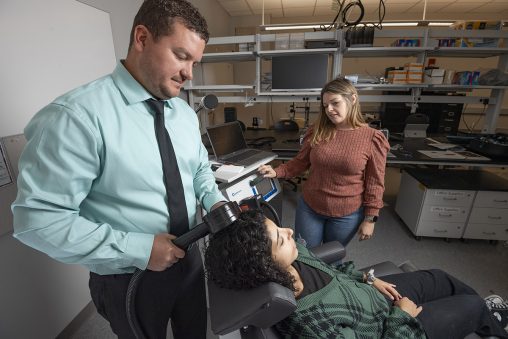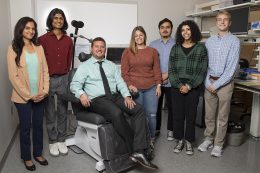Excerpt

Matt Sherwood, a research associate professor in the Department of Neuroscience, Cell Biology, and Physiology, will led a clinical trial on the use of electroencephalogram transcranial magnetic stimulation to treat post-traumatic stress disorder.
Wright State University received approximately $160,000 in funding to conduct a stage 1 clinical trial on the safety of electroencephalogram transcranial magnetic stimulation (eTMS) to treat the effects of post-traumatic stress disorder (PTSD) in military veterans and first responders.
Leading the trial will be Matt Sherwood, Ph.D., a research associate professor in the Department of Neuroscience, Cell Biology and Physiology at Wright State. Partnering with sponsor Wave Neuroscience, Sherwood and a team of four Wright State graduate students will gather data on the effects of eTMS on a group of 30 people who have PTSD.
Wave Neuroscience applied for funding from the Ohio Department of Mental Health and Addiction Services to conduct the Food and Drug Administration clinical trial. The company is also responsible for developing the software that interprets EEG recordings, which determine the stimulation parameters that are used for the personalized protocol.
Sherwood said the primary goal of the trial is to gather data on potential side effects of the treatment, side effect mitigation and potential treatment efficacy.
Some of the benefits of eTMS as a treatment for PTSD are that it is a non-invasive treatment and highly localized. Sherwood said this gives eTMS an advantage over taking medication, which is distributed throughout the entire body.
Electroencephalogram transcranial magnetic stimulation stimulates the brain with the goal of changing abnormal neural pathways that are attributed to PTSD back to a path that elicits an efficient state.
When beginning treatment, the patient receives a baseline brain activity recording to establish individualized stimulation parameters. The treatment involves a small black coil positioned over the patient’s head and emits a magnetic field in a cyclical-based paradigm that non-invasively stimulates that brain for 20 minutes each session. The treatment is repeated 20 times over five weeks.
“The treatment area of the magnetic field is about a one-centimeter sphere which induces an electrical field with it,” said Sherwood. “The electrical field causes sodium and other chemicals to move with it, which may have the potential to change brain activity at the neuronal level, to help drive normal responses to everyday emotional events.”
After researchers collect and submit the data, they will begin the second phase of the research project. The second phase will be a controlled study involving a sham group and an active group. The goal of the second phase will be to determine the efficacy of the treatment.
Researchers hope to achieve Food and Drug Administration approval of eTMS, which will enable third-party billing for the treatment of PTSD.
View the original story at sidneydailynews.com


 Wright State alum Lindsay Aitchison fulfills childhood space-agency dream
Wright State alum Lindsay Aitchison fulfills childhood space-agency dream  Wright State business professor, alumnus honored by regional technology organizations
Wright State business professor, alumnus honored by regional technology organizations  Wright State University Foundation awards 11 Students First Fund projects
Wright State University Foundation awards 11 Students First Fund projects  Gov. DeWine reappoints Board Treasurer Beth Ferris and names student Ella Vaught to Wright State Board of Trustees
Gov. DeWine reappoints Board Treasurer Beth Ferris and names student Ella Vaught to Wright State Board of Trustees  Joe Gruenberg’s 40-Year support for Wright State celebrated with Honorary Alumnus Award
Joe Gruenberg’s 40-Year support for Wright State celebrated with Honorary Alumnus Award 